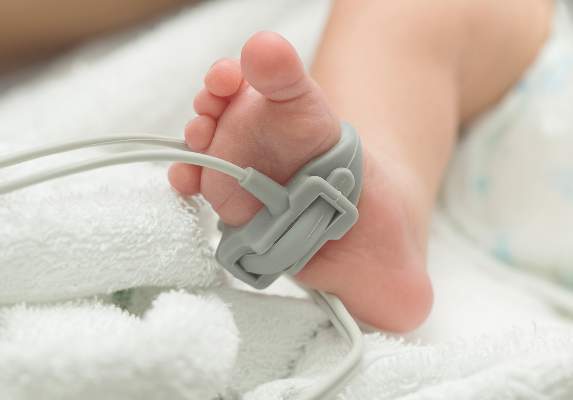User login
SAN ANTONIO – Alarm fatigue, the desensitization that can occur when clinicians are exposed to an excessive number of nonactionable clinical alarms, is an urgent concern for pediatric hospitalists, who are studying the phenomenon in both intensive care and ward settings, according to Dr. Christopher P. Bonafide.
This year the ECRI Institute named alarm fatigue the top health technology hazard of 2015. And a Joint Commission national patient safety goal, issued in 2014, demands that hospitals begin implementing alarm system management strategies by January 2016 to combat fatigue and other potential downstream consequences of being overwhelmed with alarms.
At the Pediatric Hospital Medicine 2015 meeting, Dr. Bonafide discussed ongoing work at his institution, the Children’s Hospital of Philadelphia, to pinpoint how and why alarm fatigue might be occurring there.
Dr. Bonafide and his colleagues evaluated data from in-room video cameras, bedside cardiorespiratory and pulse-oximetry monitors, and text messages communicating monitor alerts to nurses. They examined whether an alert was valid (consistent with the patient’s actual physiologic state) and actionable (meriting intervention or consultation), as well as how long it took nurses to respond.
The study was conducted during day shifts. Using data from about 5,000 alarms, and 210 hours of video from both the pediatric ward and the pediatric intensive care unit, the investigators found that 76% of alarms in the PICU were valid, and 13% were actionable. In the pediatric ward, 41% of alarms were valid, and only 1% were actionable.
Exposure to more nonactionable alarms was significantly correlated with longer response times to the patient’s bedside, Dr. Bonafide and his colleagues found. Overall, it took nurses exposed to more than 80 nonactionable alarms in the previous 2-hour period more than twice as long to respond to alarms than if they’d been exposed to 29 or fewer alarms in the preceding 2 hours (P less than .01).
“We think alarm fatigue is the most likely explanation for these findings,” Dr. Bonafide said at the meeting, sponsored by the Society of Hospital Medicine, the American Academy of Pediatrics, the AAP Section on Hospital Medicine, and the Academic Pediatric Association. He noted that a larger study was underway to look more closely at other variables, such as the patient’s acuity and the nurse’s full patient load.
In an interview, Dr. Bonafide called bedside systems such as pulse oximetry and heart rate monitoring “some of the most powerful tools we have” to detect deterioration in the hospital. But a high signal-to-noise ratio can make them “essentially useless,” he said. “They fade into the background.”
Improving alarm systems “is about making alarms less of an every-minute occurrence by improving that signal-to-noise ratio so that when that alarm buzzes, it is a good decision to interrupt what you’re doing and check on the patient to figure out what’s going on,” he said.
Some of the possible solutions to keep alarms rarer include establishing more precise heart rate and respiratory norms for pediatric patients, and adjusting the thresholds for monitoring. “We would love it if for every patient, when that alarm goes off it’s already set to a point where it’s actionable,” he said.
While Dr. Bonafide has focused on measuring and understanding alarm fatigue to date, he said he and his team are “incredibly excited to begin focusing on what we can actually do to reduce nonactionable alarms and improve outcomes for patients.”
To address this, the investigators are conducting a cluster-randomized trial evaluating a data-driven dashboard that helps physicians and nurses identify alarm hot spots, and guides them through the best ways to intervene and reduce alarms.
What’s still lacking in the hospitalist community, Dr. Bonafide said, is “consensus around what is actionable.” This will require hospitalists to meet and talk about consensus guidelines on what constitutes an actionable pulse-oximetry or heart rate alarm, when it is appropriate to intervene, and when it is absolutely necessary to intervene.
Dr. Bonafide said he plans to begin developing a protocol for this work with collaborators from Cincinnati Children’s Hospital and Lucile Packard Children’s Hospital, Stanford, Calif.
“This has the potential to really help inform decision making on thousands of patients per day across the United States,” he said.
Dr. Bonafide’s study was funded by a grant from the Pennsylvania Department of Public Health Commonwealth Universal Research Enhancement Program. His team has received funding from the National Institutes of Health, the Academic Pediatric Association, and the Society of Hospital Medicine. He declared no conflicts of interest.
SAN ANTONIO – Alarm fatigue, the desensitization that can occur when clinicians are exposed to an excessive number of nonactionable clinical alarms, is an urgent concern for pediatric hospitalists, who are studying the phenomenon in both intensive care and ward settings, according to Dr. Christopher P. Bonafide.
This year the ECRI Institute named alarm fatigue the top health technology hazard of 2015. And a Joint Commission national patient safety goal, issued in 2014, demands that hospitals begin implementing alarm system management strategies by January 2016 to combat fatigue and other potential downstream consequences of being overwhelmed with alarms.
At the Pediatric Hospital Medicine 2015 meeting, Dr. Bonafide discussed ongoing work at his institution, the Children’s Hospital of Philadelphia, to pinpoint how and why alarm fatigue might be occurring there.
Dr. Bonafide and his colleagues evaluated data from in-room video cameras, bedside cardiorespiratory and pulse-oximetry monitors, and text messages communicating monitor alerts to nurses. They examined whether an alert was valid (consistent with the patient’s actual physiologic state) and actionable (meriting intervention or consultation), as well as how long it took nurses to respond.
The study was conducted during day shifts. Using data from about 5,000 alarms, and 210 hours of video from both the pediatric ward and the pediatric intensive care unit, the investigators found that 76% of alarms in the PICU were valid, and 13% were actionable. In the pediatric ward, 41% of alarms were valid, and only 1% were actionable.
Exposure to more nonactionable alarms was significantly correlated with longer response times to the patient’s bedside, Dr. Bonafide and his colleagues found. Overall, it took nurses exposed to more than 80 nonactionable alarms in the previous 2-hour period more than twice as long to respond to alarms than if they’d been exposed to 29 or fewer alarms in the preceding 2 hours (P less than .01).
“We think alarm fatigue is the most likely explanation for these findings,” Dr. Bonafide said at the meeting, sponsored by the Society of Hospital Medicine, the American Academy of Pediatrics, the AAP Section on Hospital Medicine, and the Academic Pediatric Association. He noted that a larger study was underway to look more closely at other variables, such as the patient’s acuity and the nurse’s full patient load.
In an interview, Dr. Bonafide called bedside systems such as pulse oximetry and heart rate monitoring “some of the most powerful tools we have” to detect deterioration in the hospital. But a high signal-to-noise ratio can make them “essentially useless,” he said. “They fade into the background.”
Improving alarm systems “is about making alarms less of an every-minute occurrence by improving that signal-to-noise ratio so that when that alarm buzzes, it is a good decision to interrupt what you’re doing and check on the patient to figure out what’s going on,” he said.
Some of the possible solutions to keep alarms rarer include establishing more precise heart rate and respiratory norms for pediatric patients, and adjusting the thresholds for monitoring. “We would love it if for every patient, when that alarm goes off it’s already set to a point where it’s actionable,” he said.
While Dr. Bonafide has focused on measuring and understanding alarm fatigue to date, he said he and his team are “incredibly excited to begin focusing on what we can actually do to reduce nonactionable alarms and improve outcomes for patients.”
To address this, the investigators are conducting a cluster-randomized trial evaluating a data-driven dashboard that helps physicians and nurses identify alarm hot spots, and guides them through the best ways to intervene and reduce alarms.
What’s still lacking in the hospitalist community, Dr. Bonafide said, is “consensus around what is actionable.” This will require hospitalists to meet and talk about consensus guidelines on what constitutes an actionable pulse-oximetry or heart rate alarm, when it is appropriate to intervene, and when it is absolutely necessary to intervene.
Dr. Bonafide said he plans to begin developing a protocol for this work with collaborators from Cincinnati Children’s Hospital and Lucile Packard Children’s Hospital, Stanford, Calif.
“This has the potential to really help inform decision making on thousands of patients per day across the United States,” he said.
Dr. Bonafide’s study was funded by a grant from the Pennsylvania Department of Public Health Commonwealth Universal Research Enhancement Program. His team has received funding from the National Institutes of Health, the Academic Pediatric Association, and the Society of Hospital Medicine. He declared no conflicts of interest.
SAN ANTONIO – Alarm fatigue, the desensitization that can occur when clinicians are exposed to an excessive number of nonactionable clinical alarms, is an urgent concern for pediatric hospitalists, who are studying the phenomenon in both intensive care and ward settings, according to Dr. Christopher P. Bonafide.
This year the ECRI Institute named alarm fatigue the top health technology hazard of 2015. And a Joint Commission national patient safety goal, issued in 2014, demands that hospitals begin implementing alarm system management strategies by January 2016 to combat fatigue and other potential downstream consequences of being overwhelmed with alarms.
At the Pediatric Hospital Medicine 2015 meeting, Dr. Bonafide discussed ongoing work at his institution, the Children’s Hospital of Philadelphia, to pinpoint how and why alarm fatigue might be occurring there.
Dr. Bonafide and his colleagues evaluated data from in-room video cameras, bedside cardiorespiratory and pulse-oximetry monitors, and text messages communicating monitor alerts to nurses. They examined whether an alert was valid (consistent with the patient’s actual physiologic state) and actionable (meriting intervention or consultation), as well as how long it took nurses to respond.
The study was conducted during day shifts. Using data from about 5,000 alarms, and 210 hours of video from both the pediatric ward and the pediatric intensive care unit, the investigators found that 76% of alarms in the PICU were valid, and 13% were actionable. In the pediatric ward, 41% of alarms were valid, and only 1% were actionable.
Exposure to more nonactionable alarms was significantly correlated with longer response times to the patient’s bedside, Dr. Bonafide and his colleagues found. Overall, it took nurses exposed to more than 80 nonactionable alarms in the previous 2-hour period more than twice as long to respond to alarms than if they’d been exposed to 29 or fewer alarms in the preceding 2 hours (P less than .01).
“We think alarm fatigue is the most likely explanation for these findings,” Dr. Bonafide said at the meeting, sponsored by the Society of Hospital Medicine, the American Academy of Pediatrics, the AAP Section on Hospital Medicine, and the Academic Pediatric Association. He noted that a larger study was underway to look more closely at other variables, such as the patient’s acuity and the nurse’s full patient load.
In an interview, Dr. Bonafide called bedside systems such as pulse oximetry and heart rate monitoring “some of the most powerful tools we have” to detect deterioration in the hospital. But a high signal-to-noise ratio can make them “essentially useless,” he said. “They fade into the background.”
Improving alarm systems “is about making alarms less of an every-minute occurrence by improving that signal-to-noise ratio so that when that alarm buzzes, it is a good decision to interrupt what you’re doing and check on the patient to figure out what’s going on,” he said.
Some of the possible solutions to keep alarms rarer include establishing more precise heart rate and respiratory norms for pediatric patients, and adjusting the thresholds for monitoring. “We would love it if for every patient, when that alarm goes off it’s already set to a point where it’s actionable,” he said.
While Dr. Bonafide has focused on measuring and understanding alarm fatigue to date, he said he and his team are “incredibly excited to begin focusing on what we can actually do to reduce nonactionable alarms and improve outcomes for patients.”
To address this, the investigators are conducting a cluster-randomized trial evaluating a data-driven dashboard that helps physicians and nurses identify alarm hot spots, and guides them through the best ways to intervene and reduce alarms.
What’s still lacking in the hospitalist community, Dr. Bonafide said, is “consensus around what is actionable.” This will require hospitalists to meet and talk about consensus guidelines on what constitutes an actionable pulse-oximetry or heart rate alarm, when it is appropriate to intervene, and when it is absolutely necessary to intervene.
Dr. Bonafide said he plans to begin developing a protocol for this work with collaborators from Cincinnati Children’s Hospital and Lucile Packard Children’s Hospital, Stanford, Calif.
“This has the potential to really help inform decision making on thousands of patients per day across the United States,” he said.
Dr. Bonafide’s study was funded by a grant from the Pennsylvania Department of Public Health Commonwealth Universal Research Enhancement Program. His team has received funding from the National Institutes of Health, the Academic Pediatric Association, and the Society of Hospital Medicine. He declared no conflicts of interest.
AT PEDIATRIC HOSPITAL MEDICINE 2015
Key clinical point: Nurses’ exposure to more nonactionable pediatric alarms was found to be correlated with significantly slower response time to the patient’s bedside as their shift progressed.
Major finding: Nurses exposed to 80+ nonactionable alarms in the previous 2 hours took more than twice as long to respond to alarms as did nurses exposed to 29 or fewer alarms in the previous 2 hours (P less than .01).
Data source: 210 hours’ video and 4,962 time-stamped bedside monitor alarms on the pediatric ward and PICU at one children’s hospital; study conducted more than 120 hours in PICU and 120 hours on the ward.
Disclosures: Dr. Bonafide’s study was funded by a grant from the Pennsylvania Department of Public Health Commonwealth Universal Research Enhancement Program. His team has received funding from the National Institutes of Health, the Academic Pediatric Association, and the Society of Hospital Medicine. He declared no conflicts of interest.


